Paper Conservation: Decisions & Compromises
Paper Conservation: Decisions & Compromises
Paper Conservation: Decisions & Compromises
You also want an ePaper? Increase the reach of your titles
YUMPU automatically turns print PDFs into web optimized ePapers that Google loves.
edges. To imitate the colour of the original paper,<br />
the irregular colour patterns of the adjoining<br />
original paper parts were used as an orientation<br />
and brought together in the middle of the<br />
insert. The inserts were trimmed and chamfered<br />
to the exact shape of the loss and received a final<br />
toning with watercolours along their edges. During<br />
the dyeing processes the colour was observed<br />
several times under different light sources to test<br />
for metamerism 3 .<br />
3. Stabilizing the toned insert by lining and<br />
coating<br />
To stabilize the larger insert and to protect it<br />
from possible later distortion, in the case of<br />
climate changes in the future, the larger insert<br />
paper was lined verso with a thin Japanese kozo<br />
paper. The Japanese paper had been prepared<br />
by coating it with Lascaux® 498HV adhesive,<br />
and was applied to the verso of the insert by<br />
reactivating the adhesive with heat. The lining<br />
enhances the dimensional stability of the insert<br />
paper and protects it against distortions. The adhesive<br />
and the application method were chosen<br />
on the basis of tests conducted with insert papers<br />
lined with either starch paste, methylcellulose or<br />
Lascaux® 498HV that had been exposed to cycles<br />
of fluctuating humidity (50-95% RH). The samples<br />
were measured before, during and after the<br />
humidification to check the degree of extension.<br />
The test showed that only the samples prepared<br />
with Lascaux® 498 HV were dimensionally stable<br />
when exposed to high relative humidity. Furthermore,<br />
to smoothen the surface of the retouching<br />
paper after the extensive colouring processes,<br />
diluted methyl cellulose (Methocel® A4C) was applied<br />
with a spray gun and the surface was then<br />
dried in contact with a piece of polyester fabric<br />
(Bondina®).<br />
Fig. 2: Robert Delaunay, “The three Graces, study for ‘The<br />
City of Paris’”, normal light, after treatment (08.08.2012).<br />
4. Shaping and attaching the inserts<br />
To create a smooth transition from the insert<br />
paper to the original, the edges of the insert<br />
were chamfered from the back at a width of<br />
5 to 10 mm. Finally, the insert was adhered to the<br />
edges with starch paste, minimizing the area of<br />
adhesion, at some areas minimally overlapping<br />
onto the original by about one millimetre to<br />
cover dark stained edges, revealed after removing<br />
the former overlapping paper fills. The new<br />
inserts remain removable, leaving the historic<br />
treatment of the artwork accessible. With the<br />
old fills covered, their prominent visual distraction<br />
is eliminated, allowing a more focused perception<br />
of the painting (Fig. 2). Both retouched<br />
inserts achieve a good colour match with the<br />
whole picture. They are in-plane with the original<br />
also along their adjoining edges where there<br />
is no noticeable step in part due to the conformable<br />
nature of the insert paper. The retouched<br />
insert surface is very similar to the surface of<br />
the original. No metamerism effect was noticed<br />
when viewing the insert and the original under<br />
different light sources.<br />
Outcome and outlook<br />
Where the old insert overlapping edges were<br />
removed from the original, newly revealed original<br />
paper areas and small parts of the picture<br />
indicate design details critical to the understanding<br />
of the painting. The project required many<br />
micro-steps of technical and aesthetic decisionmaking.<br />
Key to its success was the continual,<br />
interdisciplinary consensus building in which<br />
preservation and aesthetic concerns were communicated<br />
in a differentiated way. At this point,<br />
the oil sketch will be examined together with<br />
ICOM-CC Graphic Documents Working Group Interim Meeting | Vienna 17 – 19 April 2013<br />
71
















